Comprehensive Analysis: Employee Turnover Impact on Staff Performance
VerifiedAdded on 2021/04/21
|30
|9682
|65
Report
AI Summary
This report investigates the impact of employee turnover on staff performance, aiming to identify the reasons behind employee turnover and its effects on organizational performance. The research employs a descriptive cross-sectional survey, utilizing interviews to gather data. Key findings highlight the significance of factors like workload, training, and management in influencing employee turnover. The study explores the different types of turnover, including voluntary and involuntary, and their implications on staff performance. The analysis reveals that employee turnover leads to a loss of productivity, increased training costs, and a decline in service quality. Recommendations include recognizing employee achievements, providing flexible work arrangements, and offering healthcare benefits. The report emphasizes the importance of proper employee treatment, fair promotions, and increased wages to improve staff performance and reduce turnover. The study concludes by suggesting that management should carefully consider the situation of their employees to mitigate the negative impacts of turnover and enhance overall organizational effectiveness.

IMPACT OF EMPLOYEE TURNOVER ON STAFF PERFORMANCE
Impact of Employee Turnover on Staff Performance
Name of the student:
Name of the university:
Author’s note:
Impact of Employee Turnover on Staff Performance
Name of the student:
Name of the university:
Author’s note:
Paraphrase This Document
Need a fresh take? Get an instant paraphrase of this document with our AI Paraphraser
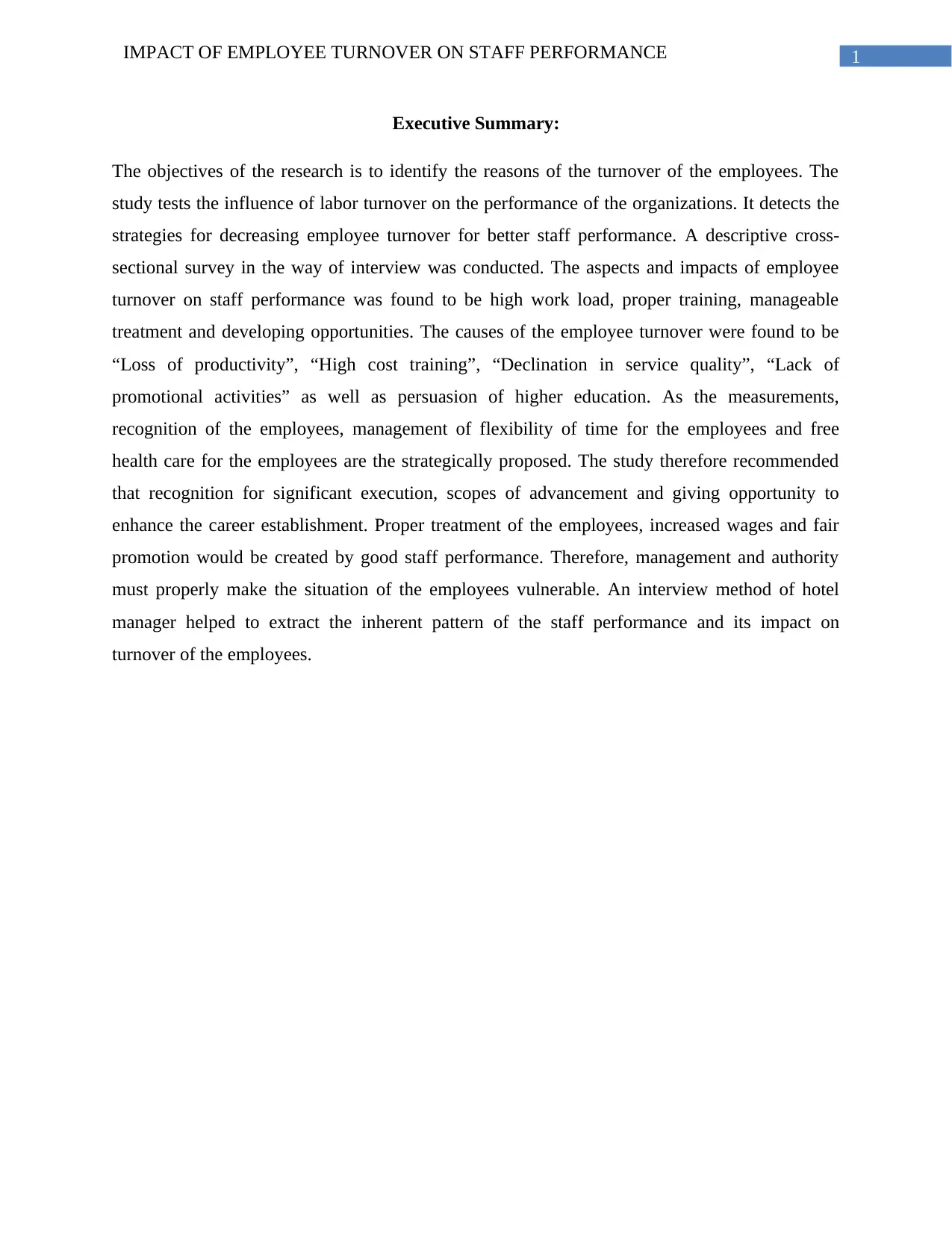
1IMPACT OF EMPLOYEE TURNOVER ON STAFF PERFORMANCE
Executive Summary:
The objectives of the research is to identify the reasons of the turnover of the employees. The
study tests the influence of labor turnover on the performance of the organizations. It detects the
strategies for decreasing employee turnover for better staff performance. A descriptive cross-
sectional survey in the way of interview was conducted. The aspects and impacts of employee
turnover on staff performance was found to be high work load, proper training, manageable
treatment and developing opportunities. The causes of the employee turnover were found to be
“Loss of productivity”, “High cost training”, “Declination in service quality”, “Lack of
promotional activities” as well as persuasion of higher education. As the measurements,
recognition of the employees, management of flexibility of time for the employees and free
health care for the employees are the strategically proposed. The study therefore recommended
that recognition for significant execution, scopes of advancement and giving opportunity to
enhance the career establishment. Proper treatment of the employees, increased wages and fair
promotion would be created by good staff performance. Therefore, management and authority
must properly make the situation of the employees vulnerable. An interview method of hotel
manager helped to extract the inherent pattern of the staff performance and its impact on
turnover of the employees.
Executive Summary:
The objectives of the research is to identify the reasons of the turnover of the employees. The
study tests the influence of labor turnover on the performance of the organizations. It detects the
strategies for decreasing employee turnover for better staff performance. A descriptive cross-
sectional survey in the way of interview was conducted. The aspects and impacts of employee
turnover on staff performance was found to be high work load, proper training, manageable
treatment and developing opportunities. The causes of the employee turnover were found to be
“Loss of productivity”, “High cost training”, “Declination in service quality”, “Lack of
promotional activities” as well as persuasion of higher education. As the measurements,
recognition of the employees, management of flexibility of time for the employees and free
health care for the employees are the strategically proposed. The study therefore recommended
that recognition for significant execution, scopes of advancement and giving opportunity to
enhance the career establishment. Proper treatment of the employees, increased wages and fair
promotion would be created by good staff performance. Therefore, management and authority
must properly make the situation of the employees vulnerable. An interview method of hotel
manager helped to extract the inherent pattern of the staff performance and its impact on
turnover of the employees.
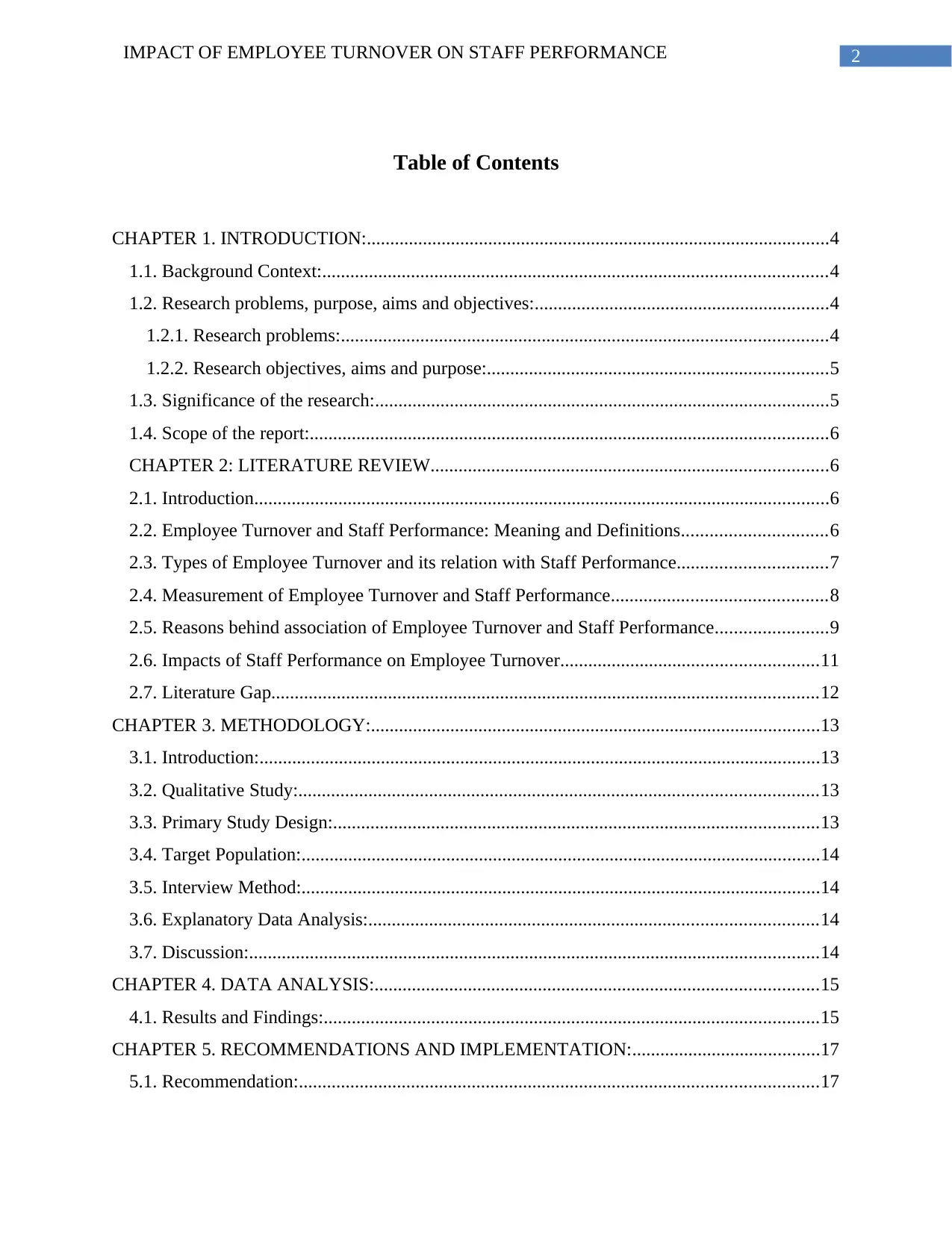
2IMPACT OF EMPLOYEE TURNOVER ON STAFF PERFORMANCE
Table of Contents
CHAPTER 1. INTRODUCTION:...................................................................................................4
1.1. Background Context:............................................................................................................4
1.2. Research problems, purpose, aims and objectives:...............................................................4
1.2.1. Research problems:........................................................................................................4
1.2.2. Research objectives, aims and purpose:.........................................................................5
1.3. Significance of the research:.................................................................................................5
1.4. Scope of the report:...............................................................................................................6
CHAPTER 2: LITERATURE REVIEW.....................................................................................6
2.1. Introduction...........................................................................................................................6
2.2. Employee Turnover and Staff Performance: Meaning and Definitions...............................6
2.3. Types of Employee Turnover and its relation with Staff Performance................................7
2.4. Measurement of Employee Turnover and Staff Performance..............................................8
2.5. Reasons behind association of Employee Turnover and Staff Performance........................9
2.6. Impacts of Staff Performance on Employee Turnover.......................................................11
2.7. Literature Gap.....................................................................................................................12
CHAPTER 3. METHODOLOGY:................................................................................................13
3.1. Introduction:........................................................................................................................13
3.2. Qualitative Study:...............................................................................................................13
3.3. Primary Study Design:........................................................................................................13
3.4. Target Population:...............................................................................................................14
3.5. Interview Method:...............................................................................................................14
3.6. Explanatory Data Analysis:................................................................................................14
3.7. Discussion:..........................................................................................................................14
CHAPTER 4. DATA ANALYSIS:...............................................................................................15
4.1. Results and Findings:..........................................................................................................15
CHAPTER 5. RECOMMENDATIONS AND IMPLEMENTATION:........................................17
5.1. Recommendation:...............................................................................................................17
Table of Contents
CHAPTER 1. INTRODUCTION:...................................................................................................4
1.1. Background Context:............................................................................................................4
1.2. Research problems, purpose, aims and objectives:...............................................................4
1.2.1. Research problems:........................................................................................................4
1.2.2. Research objectives, aims and purpose:.........................................................................5
1.3. Significance of the research:.................................................................................................5
1.4. Scope of the report:...............................................................................................................6
CHAPTER 2: LITERATURE REVIEW.....................................................................................6
2.1. Introduction...........................................................................................................................6
2.2. Employee Turnover and Staff Performance: Meaning and Definitions...............................6
2.3. Types of Employee Turnover and its relation with Staff Performance................................7
2.4. Measurement of Employee Turnover and Staff Performance..............................................8
2.5. Reasons behind association of Employee Turnover and Staff Performance........................9
2.6. Impacts of Staff Performance on Employee Turnover.......................................................11
2.7. Literature Gap.....................................................................................................................12
CHAPTER 3. METHODOLOGY:................................................................................................13
3.1. Introduction:........................................................................................................................13
3.2. Qualitative Study:...............................................................................................................13
3.3. Primary Study Design:........................................................................................................13
3.4. Target Population:...............................................................................................................14
3.5. Interview Method:...............................................................................................................14
3.6. Explanatory Data Analysis:................................................................................................14
3.7. Discussion:..........................................................................................................................14
CHAPTER 4. DATA ANALYSIS:...............................................................................................15
4.1. Results and Findings:..........................................................................................................15
CHAPTER 5. RECOMMENDATIONS AND IMPLEMENTATION:........................................17
5.1. Recommendation:...............................................................................................................17
⊘ This is a preview!⊘
Do you want full access?
Subscribe today to unlock all pages.

Trusted by 1+ million students worldwide
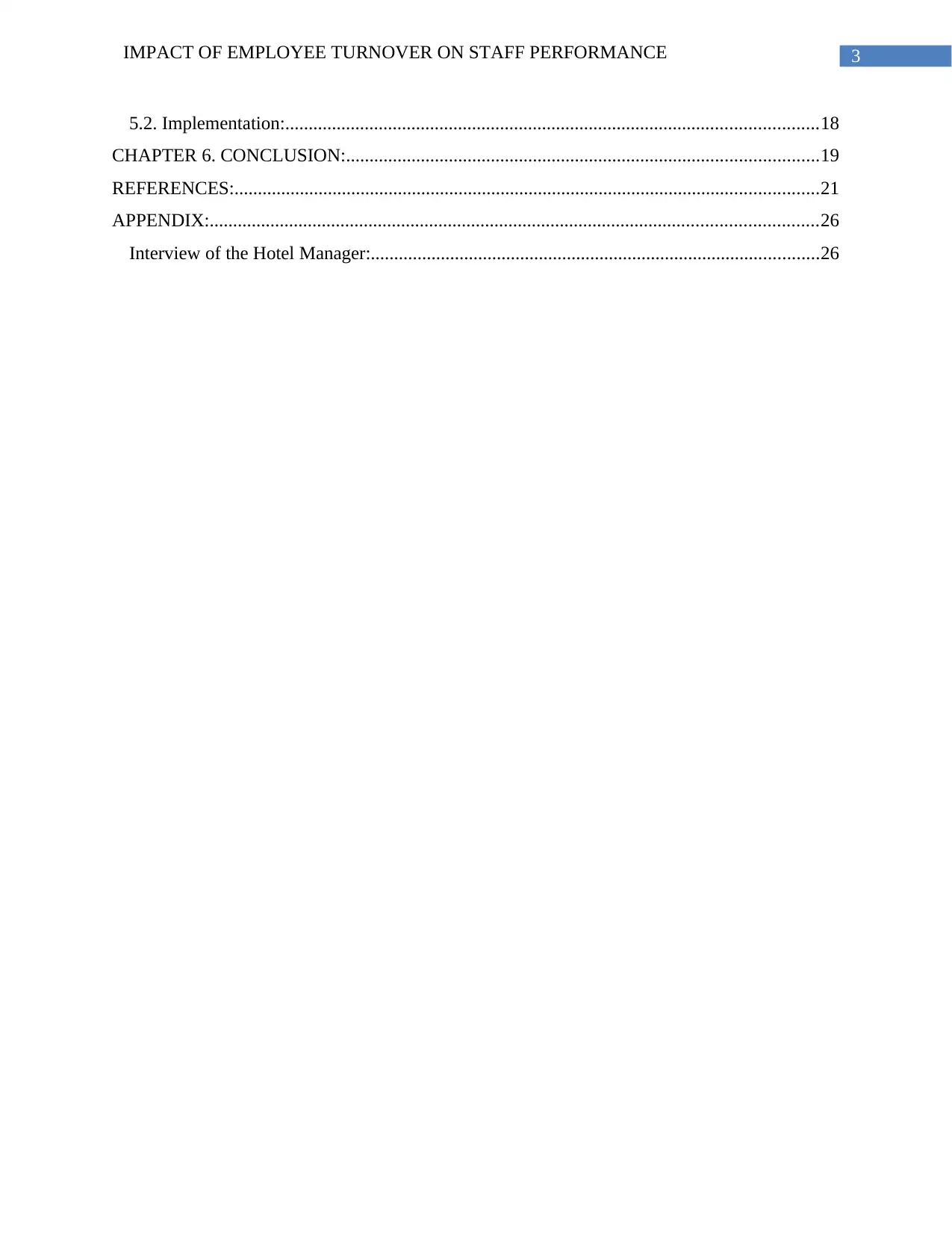
3IMPACT OF EMPLOYEE TURNOVER ON STAFF PERFORMANCE
5.2. Implementation:..................................................................................................................18
CHAPTER 6. CONCLUSION:.....................................................................................................19
REFERENCES:.............................................................................................................................21
APPENDIX:..................................................................................................................................26
Interview of the Hotel Manager:................................................................................................26
5.2. Implementation:..................................................................................................................18
CHAPTER 6. CONCLUSION:.....................................................................................................19
REFERENCES:.............................................................................................................................21
APPENDIX:..................................................................................................................................26
Interview of the Hotel Manager:................................................................................................26
Paraphrase This Document
Need a fresh take? Get an instant paraphrase of this document with our AI Paraphraser
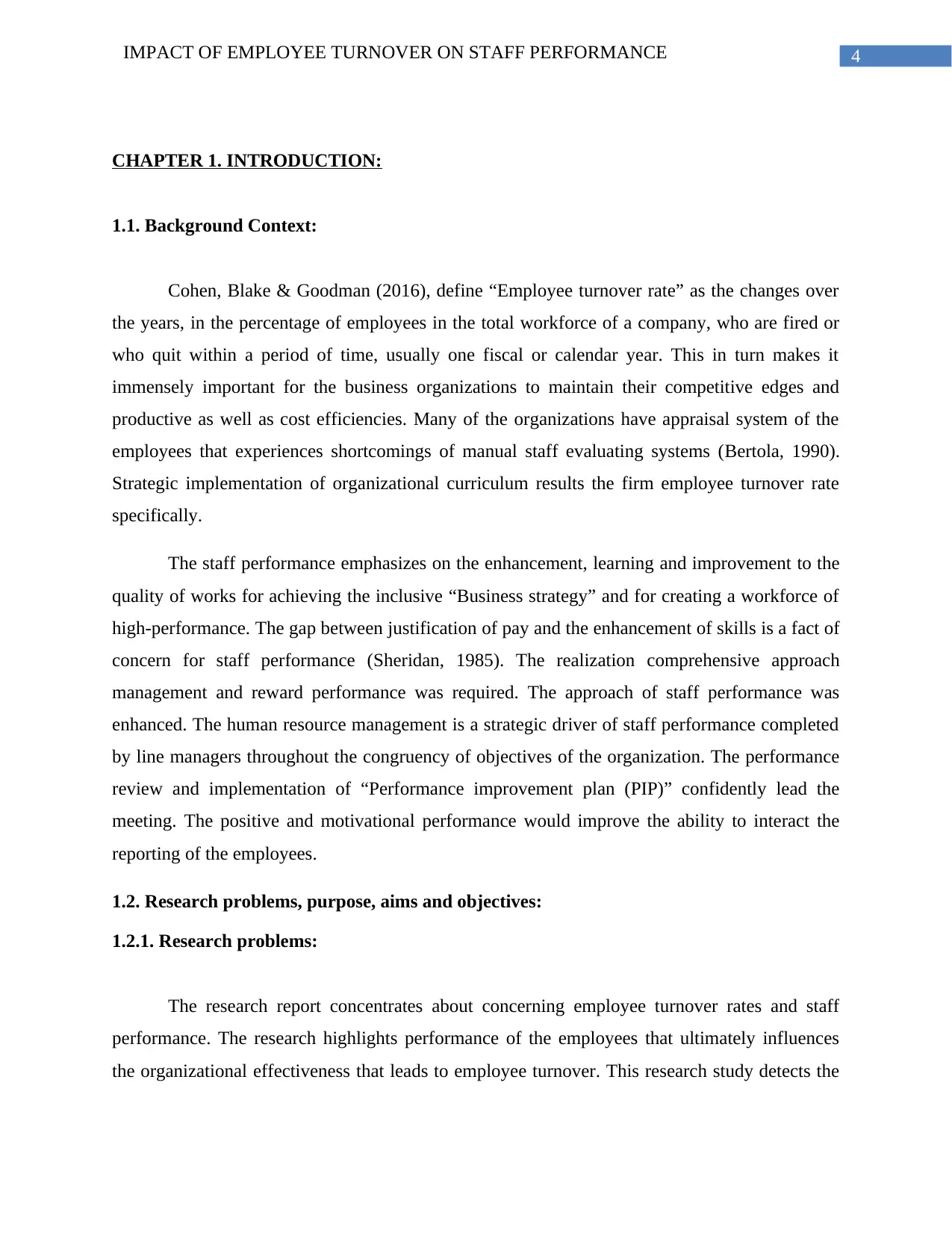
4IMPACT OF EMPLOYEE TURNOVER ON STAFF PERFORMANCE
CHAPTER 1. INTRODUCTION:
1.1. Background Context:
Cohen, Blake & Goodman (2016), define “Employee turnover rate” as the changes over
the years, in the percentage of employees in the total workforce of a company, who are fired or
who quit within a period of time, usually one fiscal or calendar year. This in turn makes it
immensely important for the business organizations to maintain their competitive edges and
productive as well as cost efficiencies. Many of the organizations have appraisal system of the
employees that experiences shortcomings of manual staff evaluating systems (Bertola, 1990).
Strategic implementation of organizational curriculum results the firm employee turnover rate
specifically.
The staff performance emphasizes on the enhancement, learning and improvement to the
quality of works for achieving the inclusive “Business strategy” and for creating a workforce of
high-performance. The gap between justification of pay and the enhancement of skills is a fact of
concern for staff performance (Sheridan, 1985). The realization comprehensive approach
management and reward performance was required. The approach of staff performance was
enhanced. The human resource management is a strategic driver of staff performance completed
by line managers throughout the congruency of objectives of the organization. The performance
review and implementation of “Performance improvement plan (PIP)” confidently lead the
meeting. The positive and motivational performance would improve the ability to interact the
reporting of the employees.
1.2. Research problems, purpose, aims and objectives:
1.2.1. Research problems:
The research report concentrates about concerning employee turnover rates and staff
performance. The research highlights performance of the employees that ultimately influences
the organizational effectiveness that leads to employee turnover. This research study detects the
CHAPTER 1. INTRODUCTION:
1.1. Background Context:
Cohen, Blake & Goodman (2016), define “Employee turnover rate” as the changes over
the years, in the percentage of employees in the total workforce of a company, who are fired or
who quit within a period of time, usually one fiscal or calendar year. This in turn makes it
immensely important for the business organizations to maintain their competitive edges and
productive as well as cost efficiencies. Many of the organizations have appraisal system of the
employees that experiences shortcomings of manual staff evaluating systems (Bertola, 1990).
Strategic implementation of organizational curriculum results the firm employee turnover rate
specifically.
The staff performance emphasizes on the enhancement, learning and improvement to the
quality of works for achieving the inclusive “Business strategy” and for creating a workforce of
high-performance. The gap between justification of pay and the enhancement of skills is a fact of
concern for staff performance (Sheridan, 1985). The realization comprehensive approach
management and reward performance was required. The approach of staff performance was
enhanced. The human resource management is a strategic driver of staff performance completed
by line managers throughout the congruency of objectives of the organization. The performance
review and implementation of “Performance improvement plan (PIP)” confidently lead the
meeting. The positive and motivational performance would improve the ability to interact the
reporting of the employees.
1.2. Research problems, purpose, aims and objectives:
1.2.1. Research problems:
The research report concentrates about concerning employee turnover rates and staff
performance. The research highlights performance of the employees that ultimately influences
the organizational effectiveness that leads to employee turnover. This research study detects the
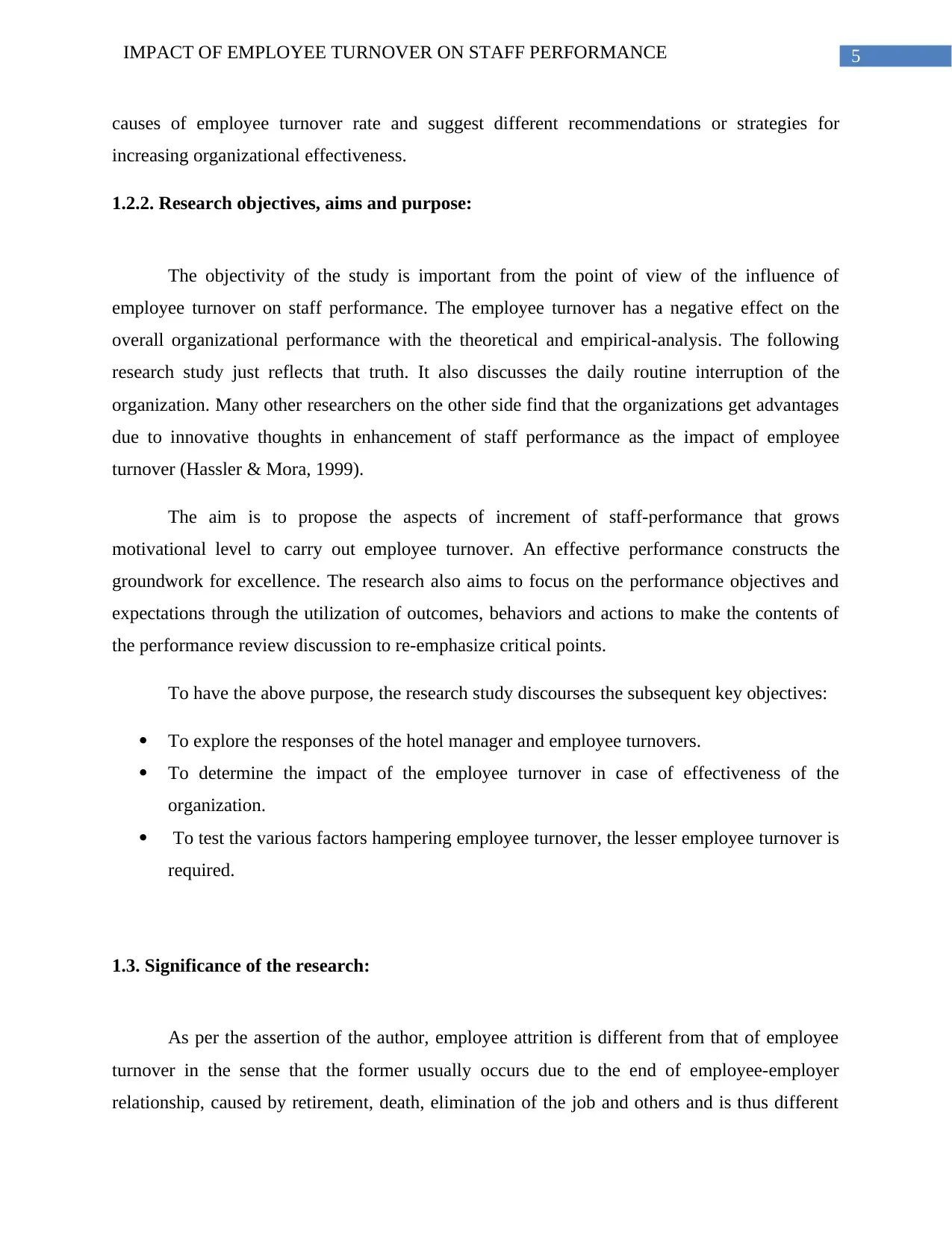
5IMPACT OF EMPLOYEE TURNOVER ON STAFF PERFORMANCE
causes of employee turnover rate and suggest different recommendations or strategies for
increasing organizational effectiveness.
1.2.2. Research objectives, aims and purpose:
The objectivity of the study is important from the point of view of the influence of
employee turnover on staff performance. The employee turnover has a negative effect on the
overall organizational performance with the theoretical and empirical-analysis. The following
research study just reflects that truth. It also discusses the daily routine interruption of the
organization. Many other researchers on the other side find that the organizations get advantages
due to innovative thoughts in enhancement of staff performance as the impact of employee
turnover (Hassler & Mora, 1999).
The aim is to propose the aspects of increment of staff-performance that grows
motivational level to carry out employee turnover. An effective performance constructs the
groundwork for excellence. The research also aims to focus on the performance objectives and
expectations through the utilization of outcomes, behaviors and actions to make the contents of
the performance review discussion to re-emphasize critical points.
To have the above purpose, the research study discourses the subsequent key objectives:
To explore the responses of the hotel manager and employee turnovers.
To determine the impact of the employee turnover in case of effectiveness of the
organization.
To test the various factors hampering employee turnover, the lesser employee turnover is
required.
1.3. Significance of the research:
As per the assertion of the author, employee attrition is different from that of employee
turnover in the sense that the former usually occurs due to the end of employee-employer
relationship, caused by retirement, death, elimination of the job and others and is thus different
causes of employee turnover rate and suggest different recommendations or strategies for
increasing organizational effectiveness.
1.2.2. Research objectives, aims and purpose:
The objectivity of the study is important from the point of view of the influence of
employee turnover on staff performance. The employee turnover has a negative effect on the
overall organizational performance with the theoretical and empirical-analysis. The following
research study just reflects that truth. It also discusses the daily routine interruption of the
organization. Many other researchers on the other side find that the organizations get advantages
due to innovative thoughts in enhancement of staff performance as the impact of employee
turnover (Hassler & Mora, 1999).
The aim is to propose the aspects of increment of staff-performance that grows
motivational level to carry out employee turnover. An effective performance constructs the
groundwork for excellence. The research also aims to focus on the performance objectives and
expectations through the utilization of outcomes, behaviors and actions to make the contents of
the performance review discussion to re-emphasize critical points.
To have the above purpose, the research study discourses the subsequent key objectives:
To explore the responses of the hotel manager and employee turnovers.
To determine the impact of the employee turnover in case of effectiveness of the
organization.
To test the various factors hampering employee turnover, the lesser employee turnover is
required.
1.3. Significance of the research:
As per the assertion of the author, employee attrition is different from that of employee
turnover in the sense that the former usually occurs due to the end of employee-employer
relationship, caused by retirement, death, elimination of the job and others and is thus different
⊘ This is a preview!⊘
Do you want full access?
Subscribe today to unlock all pages.

Trusted by 1+ million students worldwide
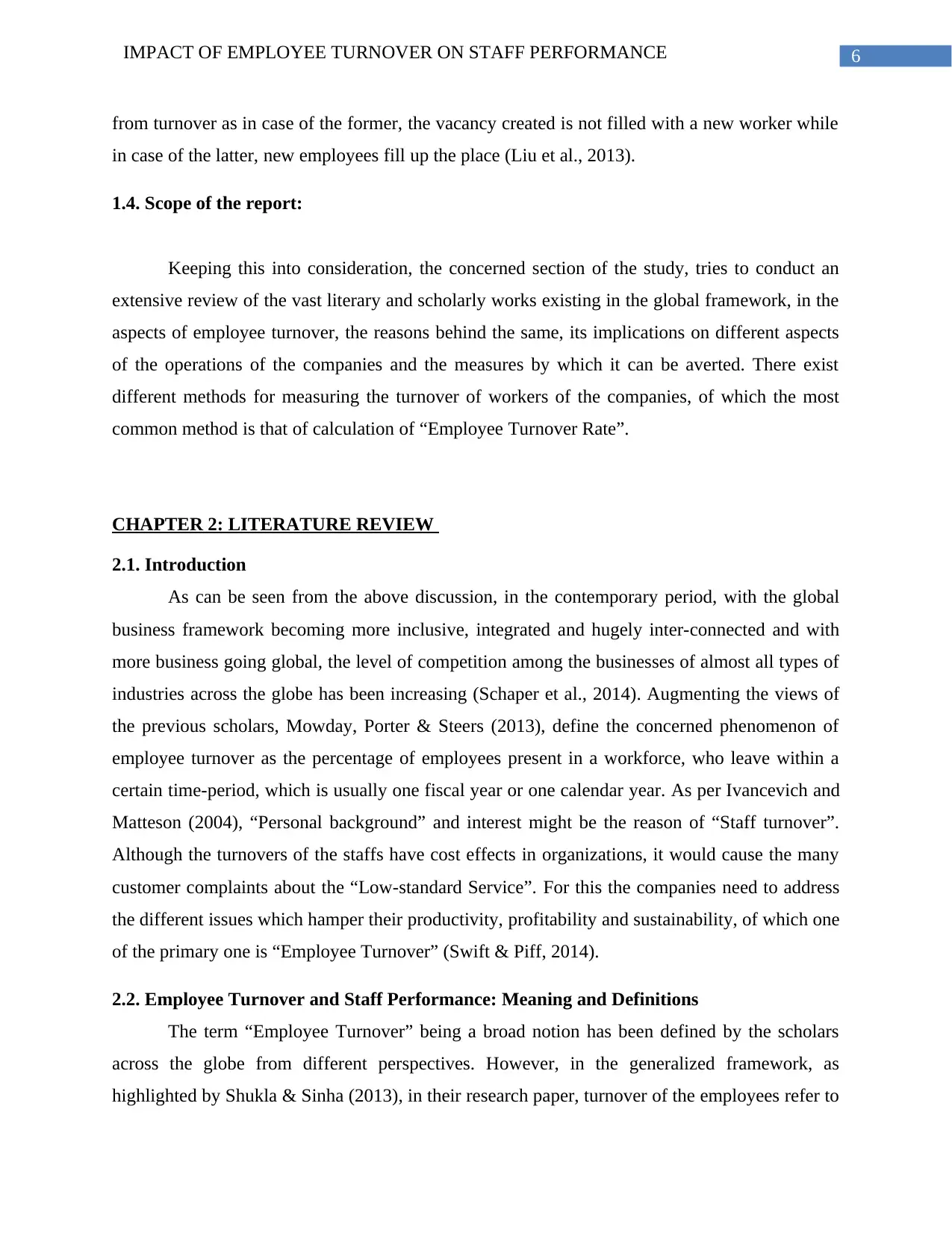
6IMPACT OF EMPLOYEE TURNOVER ON STAFF PERFORMANCE
from turnover as in case of the former, the vacancy created is not filled with a new worker while
in case of the latter, new employees fill up the place (Liu et al., 2013).
1.4. Scope of the report:
Keeping this into consideration, the concerned section of the study, tries to conduct an
extensive review of the vast literary and scholarly works existing in the global framework, in the
aspects of employee turnover, the reasons behind the same, its implications on different aspects
of the operations of the companies and the measures by which it can be averted. There exist
different methods for measuring the turnover of workers of the companies, of which the most
common method is that of calculation of “Employee Turnover Rate”.
CHAPTER 2: LITERATURE REVIEW
2.1. Introduction
As can be seen from the above discussion, in the contemporary period, with the global
business framework becoming more inclusive, integrated and hugely inter-connected and with
more business going global, the level of competition among the businesses of almost all types of
industries across the globe has been increasing (Schaper et al., 2014). Augmenting the views of
the previous scholars, Mowday, Porter & Steers (2013), define the concerned phenomenon of
employee turnover as the percentage of employees present in a workforce, who leave within a
certain time-period, which is usually one fiscal year or one calendar year. As per Ivancevich and
Matteson (2004), “Personal background” and interest might be the reason of “Staff turnover”.
Although the turnovers of the staffs have cost effects in organizations, it would cause the many
customer complaints about the “Low-standard Service”. For this the companies need to address
the different issues which hamper their productivity, profitability and sustainability, of which one
of the primary one is “Employee Turnover” (Swift & Piff, 2014).
2.2. Employee Turnover and Staff Performance: Meaning and Definitions
The term “Employee Turnover” being a broad notion has been defined by the scholars
across the globe from different perspectives. However, in the generalized framework, as
highlighted by Shukla & Sinha (2013), in their research paper, turnover of the employees refer to
from turnover as in case of the former, the vacancy created is not filled with a new worker while
in case of the latter, new employees fill up the place (Liu et al., 2013).
1.4. Scope of the report:
Keeping this into consideration, the concerned section of the study, tries to conduct an
extensive review of the vast literary and scholarly works existing in the global framework, in the
aspects of employee turnover, the reasons behind the same, its implications on different aspects
of the operations of the companies and the measures by which it can be averted. There exist
different methods for measuring the turnover of workers of the companies, of which the most
common method is that of calculation of “Employee Turnover Rate”.
CHAPTER 2: LITERATURE REVIEW
2.1. Introduction
As can be seen from the above discussion, in the contemporary period, with the global
business framework becoming more inclusive, integrated and hugely inter-connected and with
more business going global, the level of competition among the businesses of almost all types of
industries across the globe has been increasing (Schaper et al., 2014). Augmenting the views of
the previous scholars, Mowday, Porter & Steers (2013), define the concerned phenomenon of
employee turnover as the percentage of employees present in a workforce, who leave within a
certain time-period, which is usually one fiscal year or one calendar year. As per Ivancevich and
Matteson (2004), “Personal background” and interest might be the reason of “Staff turnover”.
Although the turnovers of the staffs have cost effects in organizations, it would cause the many
customer complaints about the “Low-standard Service”. For this the companies need to address
the different issues which hamper their productivity, profitability and sustainability, of which one
of the primary one is “Employee Turnover” (Swift & Piff, 2014).
2.2. Employee Turnover and Staff Performance: Meaning and Definitions
The term “Employee Turnover” being a broad notion has been defined by the scholars
across the globe from different perspectives. However, in the generalized framework, as
highlighted by Shukla & Sinha (2013), in their research paper, turnover of the employees refer to
Paraphrase This Document
Need a fresh take? Get an instant paraphrase of this document with our AI Paraphraser
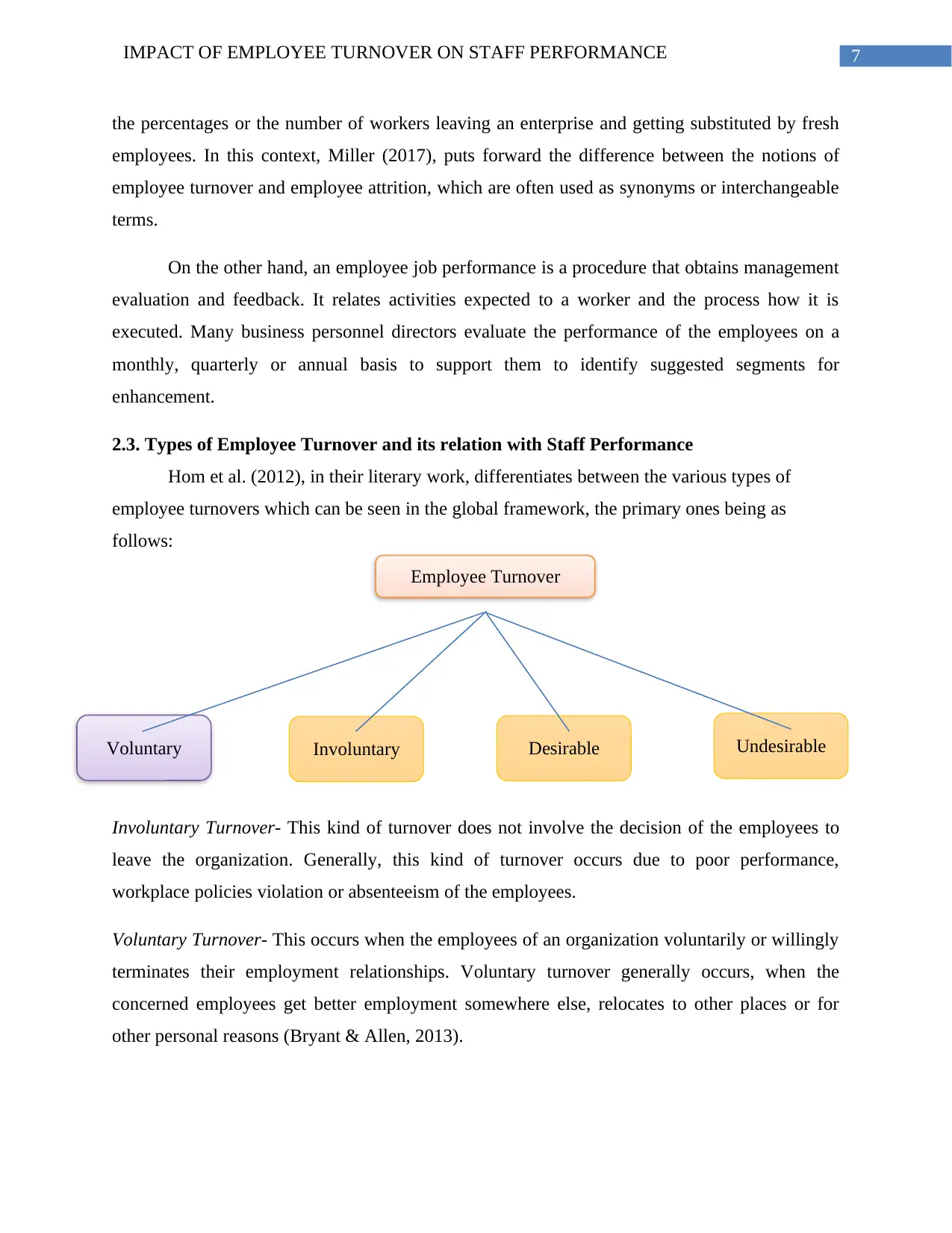
7IMPACT OF EMPLOYEE TURNOVER ON STAFF PERFORMANCE
the percentages or the number of workers leaving an enterprise and getting substituted by fresh
employees. In this context, Miller (2017), puts forward the difference between the notions of
employee turnover and employee attrition, which are often used as synonyms or interchangeable
terms.
On the other hand, an employee job performance is a procedure that obtains management
evaluation and feedback. It relates activities expected to a worker and the process how it is
executed. Many business personnel directors evaluate the performance of the employees on a
monthly, quarterly or annual basis to support them to identify suggested segments for
enhancement.
2.3. Types of Employee Turnover and its relation with Staff Performance
Hom et al. (2012), in their literary work, differentiates between the various types of
employee turnovers which can be seen in the global framework, the primary ones being as
follows:
Involuntary Turnover- This kind of turnover does not involve the decision of the employees to
leave the organization. Generally, this kind of turnover occurs due to poor performance,
workplace policies violation or absenteeism of the employees.
Voluntary Turnover- This occurs when the employees of an organization voluntarily or willingly
terminates their employment relationships. Voluntary turnover generally occurs, when the
concerned employees get better employment somewhere else, relocates to other places or for
other personal reasons (Bryant & Allen, 2013).
Employee Turnover
Voluntary Involuntary Desirable Undesirable
the percentages or the number of workers leaving an enterprise and getting substituted by fresh
employees. In this context, Miller (2017), puts forward the difference between the notions of
employee turnover and employee attrition, which are often used as synonyms or interchangeable
terms.
On the other hand, an employee job performance is a procedure that obtains management
evaluation and feedback. It relates activities expected to a worker and the process how it is
executed. Many business personnel directors evaluate the performance of the employees on a
monthly, quarterly or annual basis to support them to identify suggested segments for
enhancement.
2.3. Types of Employee Turnover and its relation with Staff Performance
Hom et al. (2012), in their literary work, differentiates between the various types of
employee turnovers which can be seen in the global framework, the primary ones being as
follows:
Involuntary Turnover- This kind of turnover does not involve the decision of the employees to
leave the organization. Generally, this kind of turnover occurs due to poor performance,
workplace policies violation or absenteeism of the employees.
Voluntary Turnover- This occurs when the employees of an organization voluntarily or willingly
terminates their employment relationships. Voluntary turnover generally occurs, when the
concerned employees get better employment somewhere else, relocates to other places or for
other personal reasons (Bryant & Allen, 2013).
Employee Turnover
Voluntary Involuntary Desirable Undesirable

8IMPACT OF EMPLOYEE TURNOVER ON STAFF PERFORMANCE
Desirable Turnover- When the employees whose performances fall below the standard or
expectations of the company are terminated and are replaced by a better performing individual,
then this kind of turnover is known as desirable turnover as it helps in increasing the efficiency,
profitability and prospects of the concerned company (Chow et al., 2006).
Undesirable Turnover- This type of turnover usually has negative implications on the company
as this signifies the phenomenon in which the companies lose out those workers whose
performance and skill levels are high and who are valuable resources for the companies. Usually
in this type of turnovers, the employee who replace the terminated ones do not have skills or
efficiency levels of that level of the terminated ones and this form of turnover is most harmful
for the companies, as put forward by Croucher et al. (2012).
It is known to all that “Employee Performance Management” is a fact of aligning the
organizational aims with the measures, developing plans, skills, contemporary requirements and
delivery of outcomes (Dess & Shaw, 2001). “Fresh classified employees” or “Classified
employees” are tending towards a “New position” needed to attend a “Probationary Service
Period”. The span of this period is resolute by the cooperative applicability to bargain
“Agreement” or “Employment program”. Professional staff do not have a probationary or trial
service period.
2.4. Measurement of Employee Turnover and Staff Performance
As highlighted by Hausknecht & Holwerda (2013), proper measurement of employee
turnover is considerably important for the employers as the same helps them not only to analyze
the reasons behind the turnover occurring in their organizations but also contribute in estimation
of cost-to-hire and other costs occurring due to employee turnover in the companies.
The staff performance has various types of measurements of employees that are –
Planning for the year
Evaluation of employees especially new employees
Staying connected with the evaluation of staff performance
Reviewing the staff performance monthly, quarterly and annually (Ongori, 2007)
The performance should be measured by written evaluation or one-on-one meeting
Preparation of measures to reform the evaluation charts
Desirable Turnover- When the employees whose performances fall below the standard or
expectations of the company are terminated and are replaced by a better performing individual,
then this kind of turnover is known as desirable turnover as it helps in increasing the efficiency,
profitability and prospects of the concerned company (Chow et al., 2006).
Undesirable Turnover- This type of turnover usually has negative implications on the company
as this signifies the phenomenon in which the companies lose out those workers whose
performance and skill levels are high and who are valuable resources for the companies. Usually
in this type of turnovers, the employee who replace the terminated ones do not have skills or
efficiency levels of that level of the terminated ones and this form of turnover is most harmful
for the companies, as put forward by Croucher et al. (2012).
It is known to all that “Employee Performance Management” is a fact of aligning the
organizational aims with the measures, developing plans, skills, contemporary requirements and
delivery of outcomes (Dess & Shaw, 2001). “Fresh classified employees” or “Classified
employees” are tending towards a “New position” needed to attend a “Probationary Service
Period”. The span of this period is resolute by the cooperative applicability to bargain
“Agreement” or “Employment program”. Professional staff do not have a probationary or trial
service period.
2.4. Measurement of Employee Turnover and Staff Performance
As highlighted by Hausknecht & Holwerda (2013), proper measurement of employee
turnover is considerably important for the employers as the same helps them not only to analyze
the reasons behind the turnover occurring in their organizations but also contribute in estimation
of cost-to-hire and other costs occurring due to employee turnover in the companies.
The staff performance has various types of measurements of employees that are –
Planning for the year
Evaluation of employees especially new employees
Staying connected with the evaluation of staff performance
Reviewing the staff performance monthly, quarterly and annually (Ongori, 2007)
The performance should be measured by written evaluation or one-on-one meeting
Preparation of measures to reform the evaluation charts
⊘ This is a preview!⊘
Do you want full access?
Subscribe today to unlock all pages.

Trusted by 1+ million students worldwide
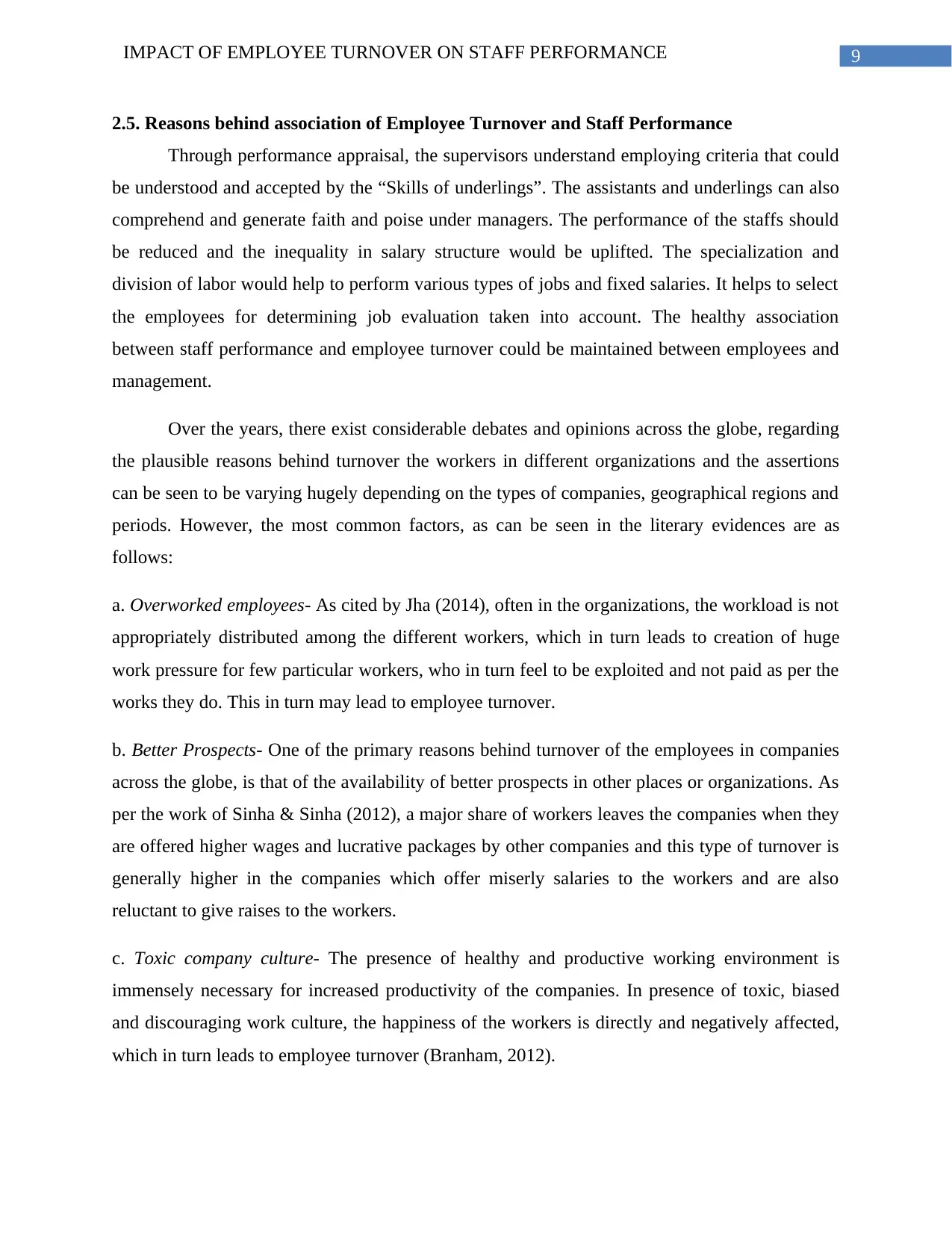
9IMPACT OF EMPLOYEE TURNOVER ON STAFF PERFORMANCE
2.5. Reasons behind association of Employee Turnover and Staff Performance
Through performance appraisal, the supervisors understand employing criteria that could
be understood and accepted by the “Skills of underlings”. The assistants and underlings can also
comprehend and generate faith and poise under managers. The performance of the staffs should
be reduced and the inequality in salary structure would be uplifted. The specialization and
division of labor would help to perform various types of jobs and fixed salaries. It helps to select
the employees for determining job evaluation taken into account. The healthy association
between staff performance and employee turnover could be maintained between employees and
management.
Over the years, there exist considerable debates and opinions across the globe, regarding
the plausible reasons behind turnover the workers in different organizations and the assertions
can be seen to be varying hugely depending on the types of companies, geographical regions and
periods. However, the most common factors, as can be seen in the literary evidences are as
follows:
a. Overworked employees- As cited by Jha (2014), often in the organizations, the workload is not
appropriately distributed among the different workers, which in turn leads to creation of huge
work pressure for few particular workers, who in turn feel to be exploited and not paid as per the
works they do. This in turn may lead to employee turnover.
b. Better Prospects- One of the primary reasons behind turnover of the employees in companies
across the globe, is that of the availability of better prospects in other places or organizations. As
per the work of Sinha & Sinha (2012), a major share of workers leaves the companies when they
are offered higher wages and lucrative packages by other companies and this type of turnover is
generally higher in the companies which offer miserly salaries to the workers and are also
reluctant to give raises to the workers.
c. Toxic company culture- The presence of healthy and productive working environment is
immensely necessary for increased productivity of the companies. In presence of toxic, biased
and discouraging work culture, the happiness of the workers is directly and negatively affected,
which in turn leads to employee turnover (Branham, 2012).
2.5. Reasons behind association of Employee Turnover and Staff Performance
Through performance appraisal, the supervisors understand employing criteria that could
be understood and accepted by the “Skills of underlings”. The assistants and underlings can also
comprehend and generate faith and poise under managers. The performance of the staffs should
be reduced and the inequality in salary structure would be uplifted. The specialization and
division of labor would help to perform various types of jobs and fixed salaries. It helps to select
the employees for determining job evaluation taken into account. The healthy association
between staff performance and employee turnover could be maintained between employees and
management.
Over the years, there exist considerable debates and opinions across the globe, regarding
the plausible reasons behind turnover the workers in different organizations and the assertions
can be seen to be varying hugely depending on the types of companies, geographical regions and
periods. However, the most common factors, as can be seen in the literary evidences are as
follows:
a. Overworked employees- As cited by Jha (2014), often in the organizations, the workload is not
appropriately distributed among the different workers, which in turn leads to creation of huge
work pressure for few particular workers, who in turn feel to be exploited and not paid as per the
works they do. This in turn may lead to employee turnover.
b. Better Prospects- One of the primary reasons behind turnover of the employees in companies
across the globe, is that of the availability of better prospects in other places or organizations. As
per the work of Sinha & Sinha (2012), a major share of workers leaves the companies when they
are offered higher wages and lucrative packages by other companies and this type of turnover is
generally higher in the companies which offer miserly salaries to the workers and are also
reluctant to give raises to the workers.
c. Toxic company culture- The presence of healthy and productive working environment is
immensely necessary for increased productivity of the companies. In presence of toxic, biased
and discouraging work culture, the happiness of the workers is directly and negatively affected,
which in turn leads to employee turnover (Branham, 2012).
Paraphrase This Document
Need a fresh take? Get an instant paraphrase of this document with our AI Paraphraser
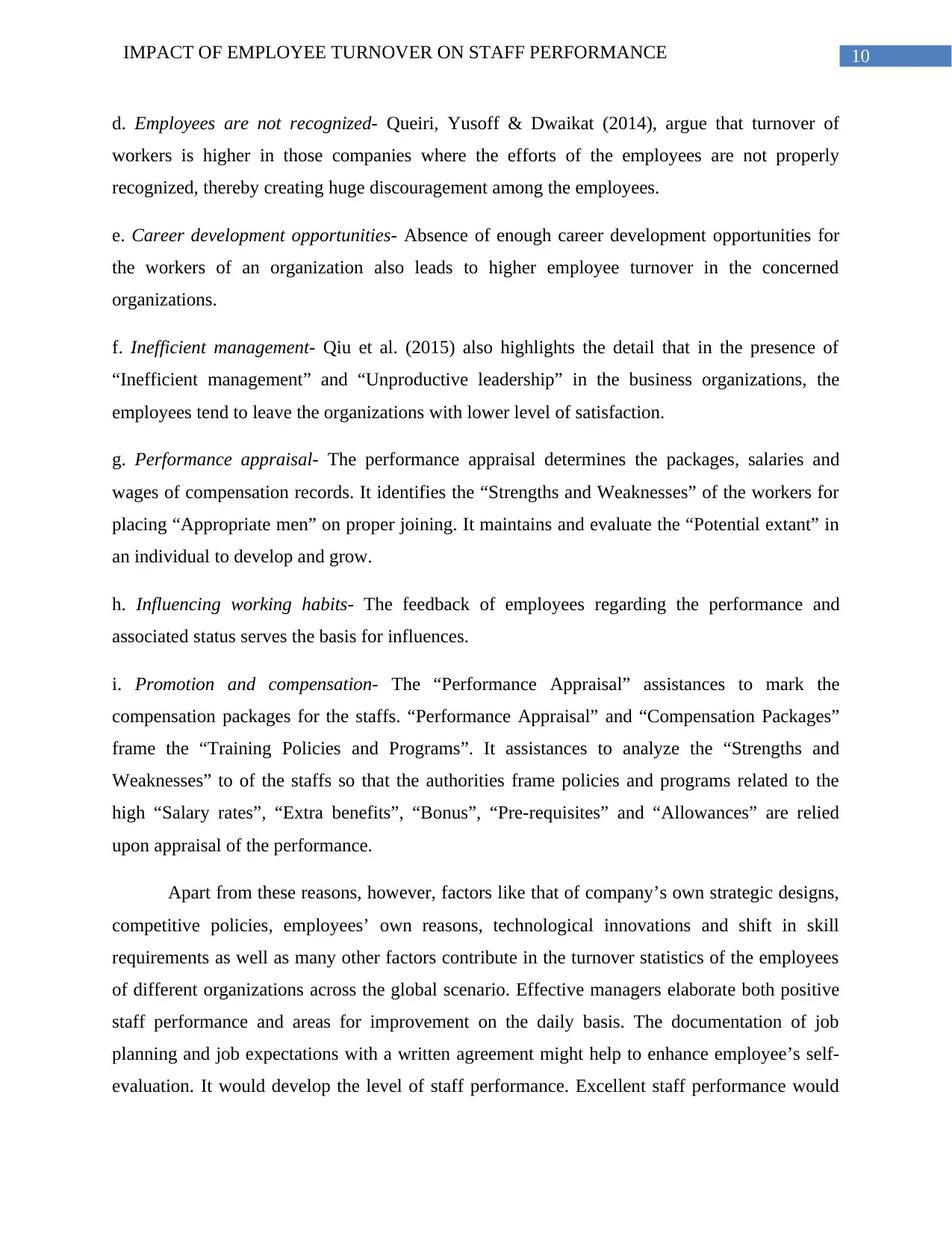
10IMPACT OF EMPLOYEE TURNOVER ON STAFF PERFORMANCE
d. Employees are not recognized- Queiri, Yusoff & Dwaikat (2014), argue that turnover of
workers is higher in those companies where the efforts of the employees are not properly
recognized, thereby creating huge discouragement among the employees.
e. Career development opportunities- Absence of enough career development opportunities for
the workers of an organization also leads to higher employee turnover in the concerned
organizations.
f. Inefficient management- Qiu et al. (2015) also highlights the detail that in the presence of
“Inefficient management” and “Unproductive leadership” in the business organizations, the
employees tend to leave the organizations with lower level of satisfaction.
g. Performance appraisal- The performance appraisal determines the packages, salaries and
wages of compensation records. It identifies the “Strengths and Weaknesses” of the workers for
placing “Appropriate men” on proper joining. It maintains and evaluate the “Potential extant” in
an individual to develop and grow.
h. Influencing working habits- The feedback of employees regarding the performance and
associated status serves the basis for influences.
i. Promotion and compensation- The “Performance Appraisal” assistances to mark the
compensation packages for the staffs. “Performance Appraisal” and “Compensation Packages”
frame the “Training Policies and Programs”. It assistances to analyze the “Strengths and
Weaknesses” to of the staffs so that the authorities frame policies and programs related to the
high “Salary rates”, “Extra benefits”, “Bonus”, “Pre-requisites” and “Allowances” are relied
upon appraisal of the performance.
Apart from these reasons, however, factors like that of company’s own strategic designs,
competitive policies, employees’ own reasons, technological innovations and shift in skill
requirements as well as many other factors contribute in the turnover statistics of the employees
of different organizations across the global scenario. Effective managers elaborate both positive
staff performance and areas for improvement on the daily basis. The documentation of job
planning and job expectations with a written agreement might help to enhance employee’s self-
evaluation. It would develop the level of staff performance. Excellent staff performance would
d. Employees are not recognized- Queiri, Yusoff & Dwaikat (2014), argue that turnover of
workers is higher in those companies where the efforts of the employees are not properly
recognized, thereby creating huge discouragement among the employees.
e. Career development opportunities- Absence of enough career development opportunities for
the workers of an organization also leads to higher employee turnover in the concerned
organizations.
f. Inefficient management- Qiu et al. (2015) also highlights the detail that in the presence of
“Inefficient management” and “Unproductive leadership” in the business organizations, the
employees tend to leave the organizations with lower level of satisfaction.
g. Performance appraisal- The performance appraisal determines the packages, salaries and
wages of compensation records. It identifies the “Strengths and Weaknesses” of the workers for
placing “Appropriate men” on proper joining. It maintains and evaluate the “Potential extant” in
an individual to develop and grow.
h. Influencing working habits- The feedback of employees regarding the performance and
associated status serves the basis for influences.
i. Promotion and compensation- The “Performance Appraisal” assistances to mark the
compensation packages for the staffs. “Performance Appraisal” and “Compensation Packages”
frame the “Training Policies and Programs”. It assistances to analyze the “Strengths and
Weaknesses” to of the staffs so that the authorities frame policies and programs related to the
high “Salary rates”, “Extra benefits”, “Bonus”, “Pre-requisites” and “Allowances” are relied
upon appraisal of the performance.
Apart from these reasons, however, factors like that of company’s own strategic designs,
competitive policies, employees’ own reasons, technological innovations and shift in skill
requirements as well as many other factors contribute in the turnover statistics of the employees
of different organizations across the global scenario. Effective managers elaborate both positive
staff performance and areas for improvement on the daily basis. The documentation of job
planning and job expectations with a written agreement might help to enhance employee’s self-
evaluation. It would develop the level of staff performance. Excellent staff performance would
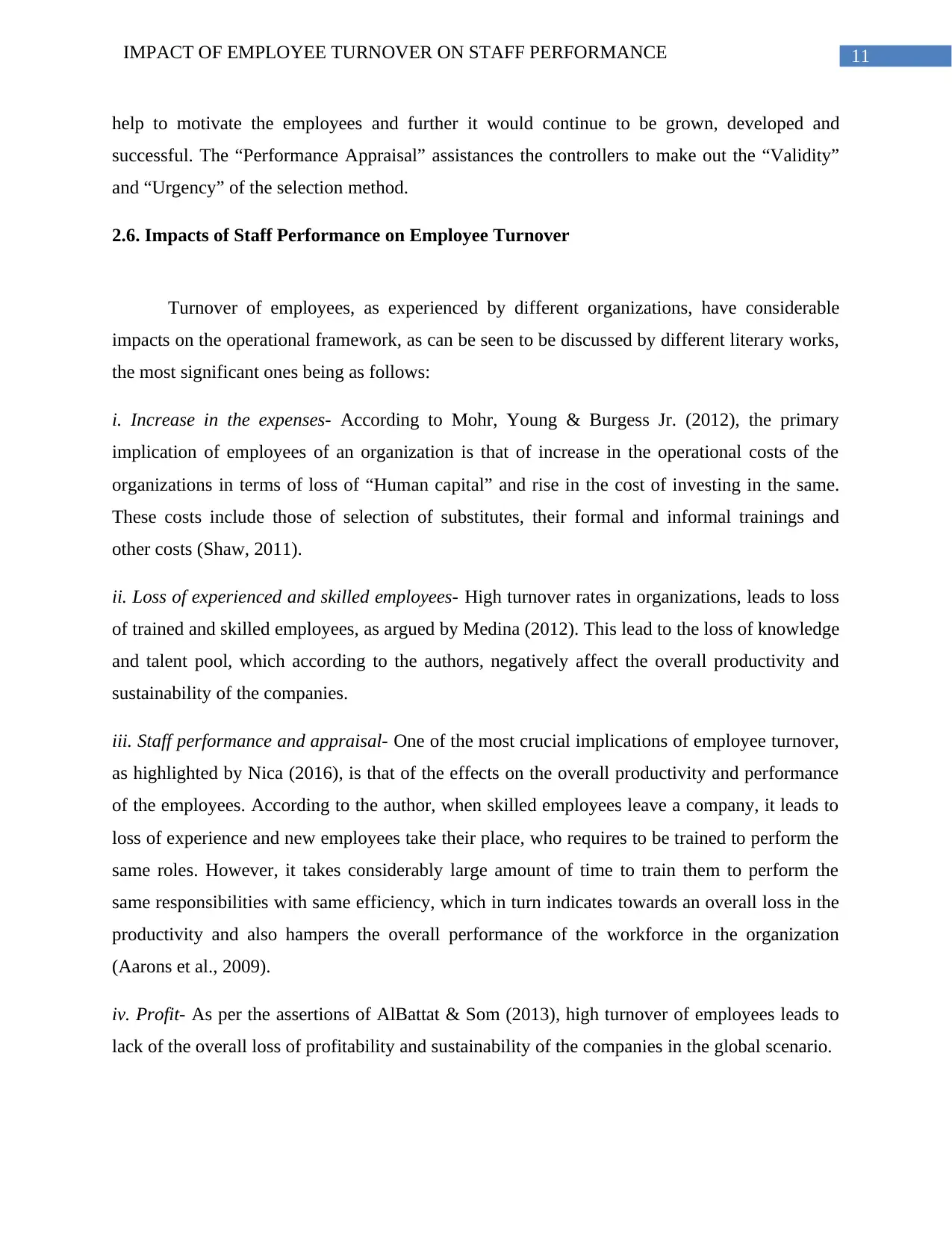
11IMPACT OF EMPLOYEE TURNOVER ON STAFF PERFORMANCE
help to motivate the employees and further it would continue to be grown, developed and
successful. The “Performance Appraisal” assistances the controllers to make out the “Validity”
and “Urgency” of the selection method.
2.6. Impacts of Staff Performance on Employee Turnover
Turnover of employees, as experienced by different organizations, have considerable
impacts on the operational framework, as can be seen to be discussed by different literary works,
the most significant ones being as follows:
i. Increase in the expenses- According to Mohr, Young & Burgess Jr. (2012), the primary
implication of employees of an organization is that of increase in the operational costs of the
organizations in terms of loss of “Human capital” and rise in the cost of investing in the same.
These costs include those of selection of substitutes, their formal and informal trainings and
other costs (Shaw, 2011).
ii. Loss of experienced and skilled employees- High turnover rates in organizations, leads to loss
of trained and skilled employees, as argued by Medina (2012). This lead to the loss of knowledge
and talent pool, which according to the authors, negatively affect the overall productivity and
sustainability of the companies.
iii. Staff performance and appraisal- One of the most crucial implications of employee turnover,
as highlighted by Nica (2016), is that of the effects on the overall productivity and performance
of the employees. According to the author, when skilled employees leave a company, it leads to
loss of experience and new employees take their place, who requires to be trained to perform the
same roles. However, it takes considerably large amount of time to train them to perform the
same responsibilities with same efficiency, which in turn indicates towards an overall loss in the
productivity and also hampers the overall performance of the workforce in the organization
(Aarons et al., 2009).
iv. Profit- As per the assertions of AlBattat & Som (2013), high turnover of employees leads to
lack of the overall loss of profitability and sustainability of the companies in the global scenario.
help to motivate the employees and further it would continue to be grown, developed and
successful. The “Performance Appraisal” assistances the controllers to make out the “Validity”
and “Urgency” of the selection method.
2.6. Impacts of Staff Performance on Employee Turnover
Turnover of employees, as experienced by different organizations, have considerable
impacts on the operational framework, as can be seen to be discussed by different literary works,
the most significant ones being as follows:
i. Increase in the expenses- According to Mohr, Young & Burgess Jr. (2012), the primary
implication of employees of an organization is that of increase in the operational costs of the
organizations in terms of loss of “Human capital” and rise in the cost of investing in the same.
These costs include those of selection of substitutes, their formal and informal trainings and
other costs (Shaw, 2011).
ii. Loss of experienced and skilled employees- High turnover rates in organizations, leads to loss
of trained and skilled employees, as argued by Medina (2012). This lead to the loss of knowledge
and talent pool, which according to the authors, negatively affect the overall productivity and
sustainability of the companies.
iii. Staff performance and appraisal- One of the most crucial implications of employee turnover,
as highlighted by Nica (2016), is that of the effects on the overall productivity and performance
of the employees. According to the author, when skilled employees leave a company, it leads to
loss of experience and new employees take their place, who requires to be trained to perform the
same roles. However, it takes considerably large amount of time to train them to perform the
same responsibilities with same efficiency, which in turn indicates towards an overall loss in the
productivity and also hampers the overall performance of the workforce in the organization
(Aarons et al., 2009).
iv. Profit- As per the assertions of AlBattat & Som (2013), high turnover of employees leads to
lack of the overall loss of profitability and sustainability of the companies in the global scenario.
⊘ This is a preview!⊘
Do you want full access?
Subscribe today to unlock all pages.

Trusted by 1+ million students worldwide
1 out of 30
Related Documents
Your All-in-One AI-Powered Toolkit for Academic Success.
+13062052269
info@desklib.com
Available 24*7 on WhatsApp / Email
![[object Object]](/_next/static/media/star-bottom.7253800d.svg)
Unlock your academic potential
Copyright © 2020–2025 A2Z Services. All Rights Reserved. Developed and managed by ZUCOL.





